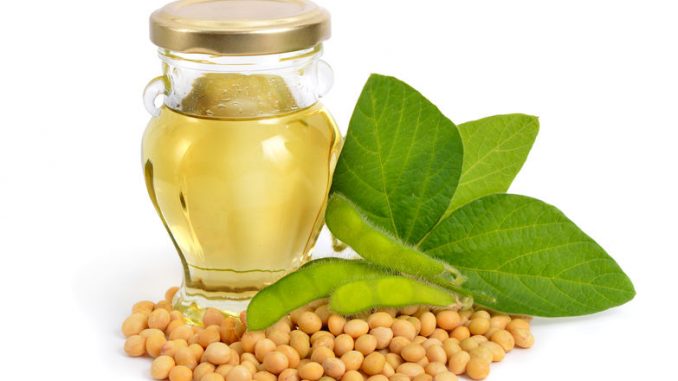
Soybean oil is a good source of fat, especially omega-3 fatty acids and polyunsaturated fats. All these fats have their own health benefits but too much ‘pure fat’ presents a major health issue. Consuming soybean oil along with other oils in moderation, as a replacement for animal fats like lard and suet contributes greatly to the healthiness of your diet.
The USA is the pre-eminent producer of soybeans (Glycine max) with 33 per cent of the world’s production. It is also unsurprisingly one of the largest commercially grown vegetables in the world. Soybean oil is now the most consumed edible oil too and forms two-thirds of the volume used in the United States. The soybean was originally found in east Asia such as Japan. Soybeans which are picked at 80% maturity are known as edamame beans and these too have similar health benefits.
Soybean oils are refined and blended to such an extent that many types are available depending on application.
Nutrition Of Soybean Oil And Comparison With Lard
When we compare lard and soybean oil, we can see significant differences in the composition of fats. Lard has a slightly lower calorific content of 115 calories per serving (equates to 1 tablespoon) to soybean oil which is 120 calories per serve. The total fat content of lard is also higher at 12.8 grams/serve compared to 13.6 grams/serve for soybean oil. However, soybean oil contains just 2.1 grams/serve of saturated fats and has a significantly higher content of unsaturated fats. Lard is nearly 40 per cent saturated fat, containing 5 grams of this fat with the remainder as unsaturated fats.
Soybean is a declared allergen, however soybean was shown in 2003 to be non-allergenic to those with a soybean allergy (Taylor et al., 2003).
FDA Claims
Soybean oil attracts a great deal of interest, so much so that qualified health claims now feature as a key part of this ingredient’s story. In July 2017, the US Food and Drug Administration (FDA) approved a significant health claim linking the consumption of soybean oil to a reduced risk of coronary heart disease. The business, Bunge North America which supplies this oil, filed petition with the FDA that covered in summary, a number of human clinical trials showing the benefits.
The new heart-healthy claim states, “Supportive but not conclusive scientific evidence suggests that eating about 1 1/2 tablespoons (20.5 g) daily of soybean oil, which contains unsaturated fat, may reduce the risk of coronary heart disease. To achieve this possible benefit, soybean oil is to replace saturated fat and not increase the total number of calories you eat in a day. One serving of this product contains [x] grams** of soybean oil.”
Product developers must include at least 5g of soybean oil per serving in any food or menu item, if they want to ensure the heart health claim with the oil is made. The applicable criteria must also be met for saturated fat, trans fat, cholesterol, and sodium content in these products or menu items too.
In order to be considered for the heart healthy claim, food products containing soy bean oil, including margarine, margarine substitutes and margarine products must also be a good source of one of six beneficial nutrients identified by the FDA.
Soybean oil, soybean oil blends, salad dressings, and shortenings can carry the claim without having to be a good source of one of these six nutrients. They must however as explained before meet criteria for saturated, trans fat, cholesterol, and sodium content.
The press statement released by Bunge is available as is the FDA statement relating to the claim can be accessed here.
Qualisoy have also used biotechnological innovation to create high oleic acid containing soybean oils. They have been developing a soybean rich in omega-3 which is claimed to benefit the whole supply chain. This omega-3 soybean is rich in various fatty acids including stearidonic acid (SDA) based omega-3 fatty acids.
Use Of Soybean Oil
Soybean oil does not have a high flashpoint which makes it a poor cooking oil. It is not recommended for high-heat applications like grilling, frying or roasting. The oil is good for dressings and marinades. It has a clean, non-descript and neutral flavour but lacks body for mayonnaise and salad dressings. Product developers often use the oil as a base for spicy, pungent flavoured dressings.
Please note this page contains links to our affiliate marketing partner. Please read our affiliate disclosure.
Nice